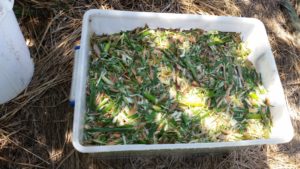With the Playing with Pulp workshop fast approaching, I have been concentrating on utilising the Hollander beater that I have on loan for a month from my papermakers group. As it is Easter and a wonderful gardening season with rain and lush growth, I have been busy setting aside some plants for papermaking in keeping with my theme of using garden seasonal prunings and thinnings. We removed an understory of sweet potato from beneath one of our seedling mandarin trees, and since it was such a large amount, I cut up the stalks ( it was not stiff enough to put through the chipper) and cooked them. Sweet potato vine is a very tough fibre and I had made some very fibrous paper after the last pruning, when we first got home from Europe, but I didn’t have the Hollander beater then and I wanted to know how much difference it would make. Even after 5 hours of beating still seems quite stiff, but I will have to couch some sheets to see whether it changes the character of the paper.
With the bullrushes we collected from Willows Park, I cooked, rinsed and prepared 3 batches with some added cotton linters and some ochre in one batch (batch 1). This took several hours of beating for each batch but gave a promising result. After clearing the bed behind the Dragon fruit, I cut up a batch of arrowroot stalks have completed a batch of arrowroot, and it has also given a very different result to the previous time I made arrowroot paper, which gave a coarse result that I used for the curtains on the caravans in my work for Carnivale in 2016.
It made me a bit sad to have to clear the verdant, beautiful heart-shaped leaves of the Ceylon spinach from under the orange tree, but it was starting to climb into the branches, and we needed biomass for the compost heap. I took my secateurs and cut up many stalks because once again it wasn’t stiff enough to feed into the chipper. There was a lot of warrigal greens stalks in the compost bay too as I had been cleared from another bed, so I made a “mixed spinaches” batch which, while cooking, smelled like spinach pie steaming. I was keen to put int through the Hollander beater, as I hadn’t ever attempted Spinach stalk paper before. The ceylon spinach is mucilaginus and produced a slimy pulp which was going quite soft, and looked like it might keep its green colour. However I rashly decided to add the chipped and cooked trunk from a Hibiscus Manihot tree that had died. I had put it through the chipper twice, but it was flying everywhere and I was losing more than I could catch, so I didn’t go for a third time through. The wood was still a bit coarse and pulpy, and jammed the teeth of the beater repeatedly, and I had to stop it five or six times to remove pulpy wood jammed in the beater teeth. I just unloaded the pulp tonight and have it draining.
Then Glen got interested in the beating process and the way it transforms the fibre, and cut some Galangal (Thai Ginger) stalks for me to test. It went through the chipper brillinatly and we put a fertiliser bag over the outlet to catch the flying chips. I have cooked up a couple of batches so that will be the next fibre we try. Glen also had the idea of putting some okra pods through with the batch to haelp keep the fibres in suspension. I have some in the freezer that I can thaw out and try.
 Bullrushes chipped and soaking
Bullrushes chipped and soaking
0 comments on “Easter gardening and papermaking”